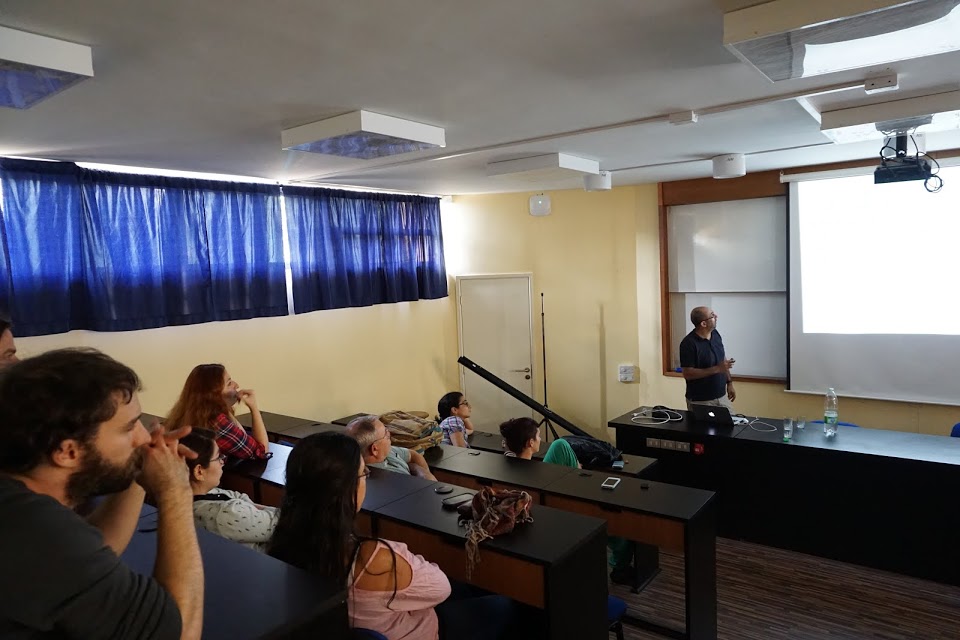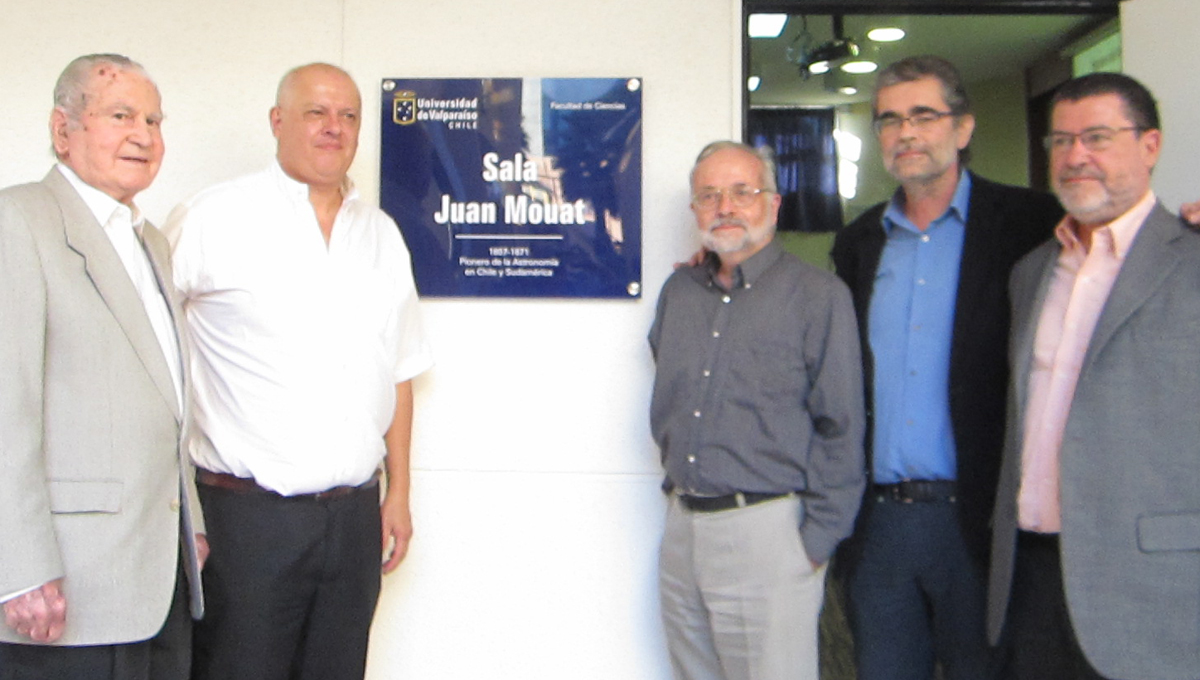 Abril 14, 2015-Noticia IFA
Abril 14, 2015-Noticia IFA
El jueves 9 de Abril de 2015 recien pasado, el Instituto de Fisica y Astronomía - IFA homenajeó a quien instaló el primer observatorio en las costas del Pacífico en América, un Valparaíso del año 1843. La Sala 11-A, en que hoy se dictan seminarios astrofísicos de excelencia para los investigadores y alumnos de postgrado del IFA, reaizados por investigadores nacionales e internacionales, se llamará en adelante, Sala Juan Mouat. Presentes también en la ceremonia, que reunió docentes, investigadores y alumnos de pregrado y postgrado del IFA, se encontraban sus descendientes, Sr. Victor Mouat (bisnieto, Médico Traumatólogo y co-fundador de la Clínica Las Condes), Sr. Francisco Mouat (Periodista) y el Sr. Leopoldo Infante (Cosmólogo de la Pontificia Universidad Católica de Chile), estos dos ultimos, tataranietos de este pionero de la astronomía amateur en Chile. Francisco Mouat dedicó algunas emotivas palabras durante la ceremonia para resaltar algunas características de su antepasado, entretejiendola con poesía y recuerdos de esa época. En la imágen, la placa con el nombre de nuestra Sala Juan Mouat. En la imágen, de izquierda a derecha, Victor Mouat (bisnieto), Dr. Michel Curé (Director Instituto de Fisica y Astronomía, Dr. Nikolaus Vogt (gestor de la iniciativa), Francisco Mouat y Leopoldo Infante.
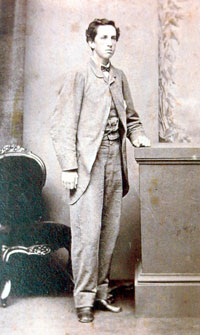 Juan Mouat Walters (1809-1871) relojero y óptico de profesión compró el terreno donde antiguamente se inssaló el antiguo Castillo San José (actual Museo Lord Cochrane) lugar en el cual, dos años mas tarde, 1843, instalaría el Primer Observatorio Astronómico en Chile, a pocos dias de la aparición del gran cometa de 1843 (luego denominado 1843 I y C/1843). Multifacético personaje del siglo 19 dedicó su vida a varios proyectos, entre ellos obtener la concesión para la construcción del ferrocarril entre Copiapó y Caldera (era además ingeniero), y formar parte, como fundador, del primer equipo de Bomberos de Valparaíso. Fallece el año 1871 en Valparaíso.
Juan Mouat Walters (1809-1871) relojero y óptico de profesión compró el terreno donde antiguamente se inssaló el antiguo Castillo San José (actual Museo Lord Cochrane) lugar en el cual, dos años mas tarde, 1843, instalaría el Primer Observatorio Astronómico en Chile, a pocos dias de la aparición del gran cometa de 1843 (luego denominado 1843 I y C/1843). Multifacético personaje del siglo 19 dedicó su vida a varios proyectos, entre ellos obtener la concesión para la construcción del ferrocarril entre Copiapó y Caldera (era además ingeniero), y formar parte, como fundador, del primer equipo de Bomberos de Valparaíso. Fallece el año 1871 en Valparaíso.
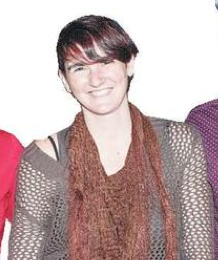 April 14, 2015-IFA News
April 14, 2015-IFA News
"Carcajadas científicas" es el nombre del stand up comedy que mostró de manera lúdica las investigaciones de la astrónoma Amelia Bayo y del químico Marcelo Kogan". The daily newspaper "El Mercurio de Antofagasta" tells us all about this event in its April 12 issue, which covers the participation of the investigator of our Instituto de Fisica y Astronomía, Dr. Amelia Bayo. (Image credits: El Mercurio de Antofagasta). Associated link: El Mercurio de Antofagasta
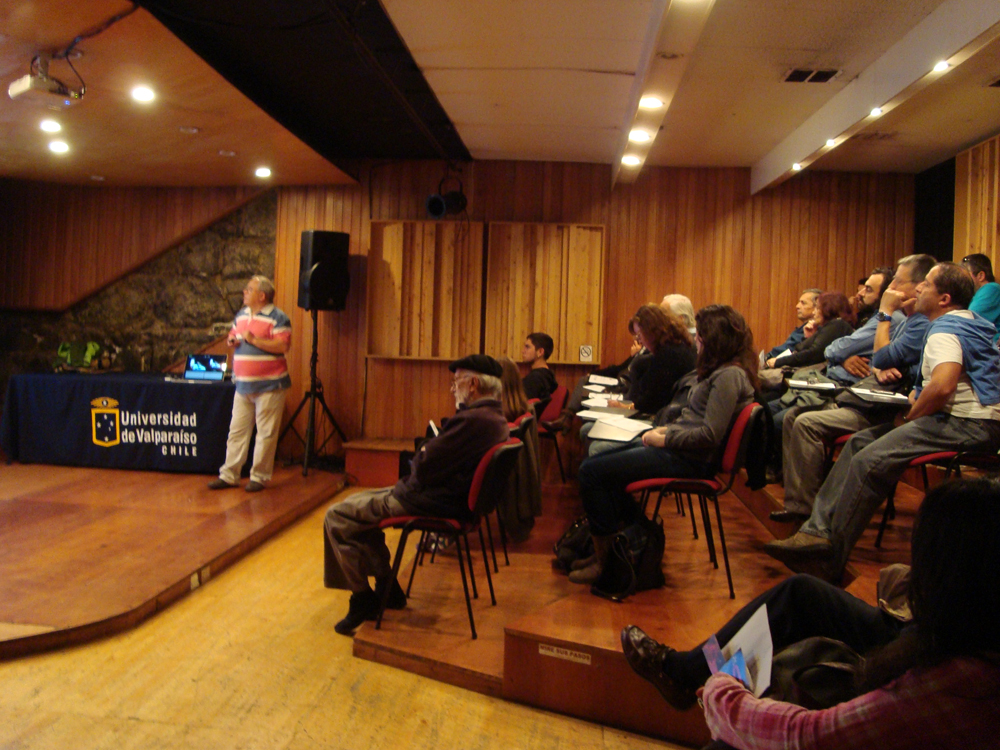 March 21, 2015 IFA News
March 21, 2015 IFA News
On saturday March 21, a few hours after the official beginning of Autumm, and coincidentally with a total solar eclipse in the northern hemisphere, Chile celebrated National Astronomy Day for the second consecutive year. Dr. Radostin Kurtev, professor and investigator at the Instituto de Física y Astronomía-IFA, of the U. de Valparaíso, and in representation of the Instituto Milenio para la Astrofísica, MAS, of which he is member, gave a talk, titled "Mundos Fríos y Extraños. El Descubrimiento y Naturaleza de las Enanas Marrones” . MAS organized and coordinated these "Tertulias Astronómicas" ("Astronomy Conversations") for celebrating this day en Santiago (Dr. Alejandro Clocchiatti), Concepción (Dr. Wolfgang Gieren) and Valparaíso. 72 people came to listen to Dr. Kurtev´s talk in Valparaíso, showing great interest, as he revealed the enormous challenge for the newer generations regarding the search for new worlds and cool misterious stars and, perhaps, the elusive dark matter, by means of the new great observatories like ALMA (Atacama Large Millimetre Array) and newer instruments yet to be built, covering most specially the millimetre and submillimetre wavelenghts. The event was closed with a Celebration Coffee in the hall, amongst an exhibition of 14 colourful astronomy images, courtesy of the Núcleo Milenio para la Vía Láctea, in which Dr. Jordanka Borissova collaborates (IFA) together with Dr. Marcio Catelán (Pontificia Universidad Católica) as part of Dr.Nikolaus Vogt´s (IFA) outreach activities.
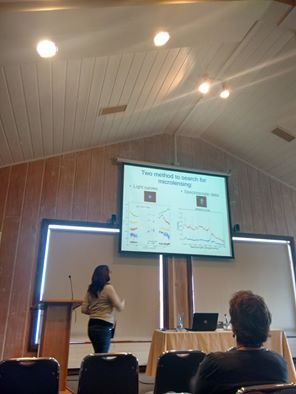
March 3, 2015 IFA News.
Karina Rojas, student of the PhD in Astrophysics postgraduate program of the Instituto de Física y Astronomía was awarded the "Graduate Student Prize Lecture" by the Sociedad Chilena de Astronomía, Sochias. This is the second year the prize has been awarded, always to the best Thesis for which all postgraduate students in Chile compete. The selected work is then presented in the Plenary Session at the Sochias Anual Conference. Karina Rojas presented her talk "Strong Chromatic Microlensing in HE0047-1756 and SDSS1155+6456", part of her Master´s thesis with which she published a paper with the results last December.
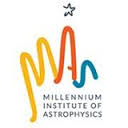
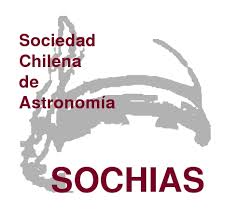 Marzo 6, 2015. Noticia IFA
Marzo 6, 2015. Noticia IFA
El Dia de la Astronomía en Chile, será celebrado el sabado 21 de Marzo proximo en todo el pais. Nuestro Instituto de Fisica y Astronomía participará a través de sus docentes e investigadores, Dra. Amelia Bayo y Dr. Radostin Kurtev, quienes dictarán charlas para el público interesado en las ciudades de Puerto Natales (organizada por Sociedad Chilena de Astronomía, SOCHIAS) y Valparaíso ("Tertulias Astronomicas" organizada por el Instituto Milenio de Astrofísica, MAS) respectivamente. Estas charlas son de entrada liberada.
March 5, 2015-IFA Newsticia IFA.
Amelia Bayo, professor and investigator of IFA will partiicpate in Puerto de Ideas Antofagasta 2015, an event which brings together scientists who undertake outreach, in a meeting charaterized by reflections, curiosity and investigation in science in Chile and Latinamerica
Talking about science can be fun - Scientific Outreach Dialogues
¿Why not do science and have fun at the same time? ¿Erudition and entertainment? ¿Why do we assume that science is only for specialists? Science forms part of our daily lives. Apples fall on people´s heads due to something appparently complex yet as simple as the force fop gravity. Two persons cannot bathe together in the same full bathtub without wreaking havoc, if we take into account Archimedes Principle or that of hydrostatic push.
In an attempt to apporach science in a new way, “Stand up Comedy Científico” will be developed by a team from the Centro Cultural de España, the dramaturg Jesús Codina and actors Carola Paulsen and José Martínez, around scientific proposals belonging to Dr. Amelia Bayo and Chemist Dr. Marcelo Kogan, originated in the Festival de Cheltenham and wjhich is very popular today in Spain through FameLab.
Dr. Amelia Bayo, from the Instituto de Física y Astronomia of our University, has a PhD in Physics from the Universidad Autónoma de Madrid, Madrid. She is professor/Investigator of the Universidad de Valparaíso. Support astronomer at ESO´s Observatorio del Cerro Paranal in Chile. Specialist in: low mass stellar formation, disk evolution, substellar objects, Virtual Observatory and Astrostatistics.
Associated links: Puerto de Ideas Antofagasta 2015 - Invited to the Event
 February 18, 2015- IFA News.
February 18, 2015- IFA News.
Adam Hardy, a PhD student at IFA, and his supervisor Matthias R. Schreiber have led a team who have published the first science results with a groundbraking new instrument. The Spectro-Polarimetric High-contrast Exoplanet REsearch instrument, or SPHERE, has been installed on ESO’s Very Large Telescope (VLT) at the Paranal Observatory in Chile, and its main goal is to find and characterise substellar objects such as brown dwarfs and giant planets orbiting nearby stars by direct imaging. This is an extremely challenging task as such objects are both very close to their parent stars in the sky and also very much fainter.
The team observed with SPHERE the close binary star V471 Tau aiming for a final confimation of the circumbinary brown dwarf that has been predicted around V471 Tau for more than twenty years. V471 Tau is an eclipsing binary star consisting of a white dwarf and a normal main sequence star with an orbital period of 0.5 days. When the main sequence star passes in front of the white dwarf, the light emitted from the white dwarf gets blocked and the system appears to be fainter, but the resulting eclipse signal has been found to periodically vary, and this has been interpreted as evidence for a circumbinary brown dwarf orbiting the stars every 30 years.
The observations performed with SPHERE by the IFA team now show that the brown dwarf does not exist. This result has potentially far reaching consequences, as circumbinary planets or brown dwarfs have become the standard explanation for eclipse timing variations in close binary stars.
The damaging evidence for the circumbinary brown dwarf interpretation of V471 Tau provided by the SPHERE observations shows that at least in this system, and maybe in the others too, another mechanism is driving the eclipse timing variations. The paper has appeared in the Astrophysical Journal Letters and a press release has been released by ESO.
Associated links: Press Release from European Southern Observatory - Article in Astrophysical Journal Letters - News in National Geographic
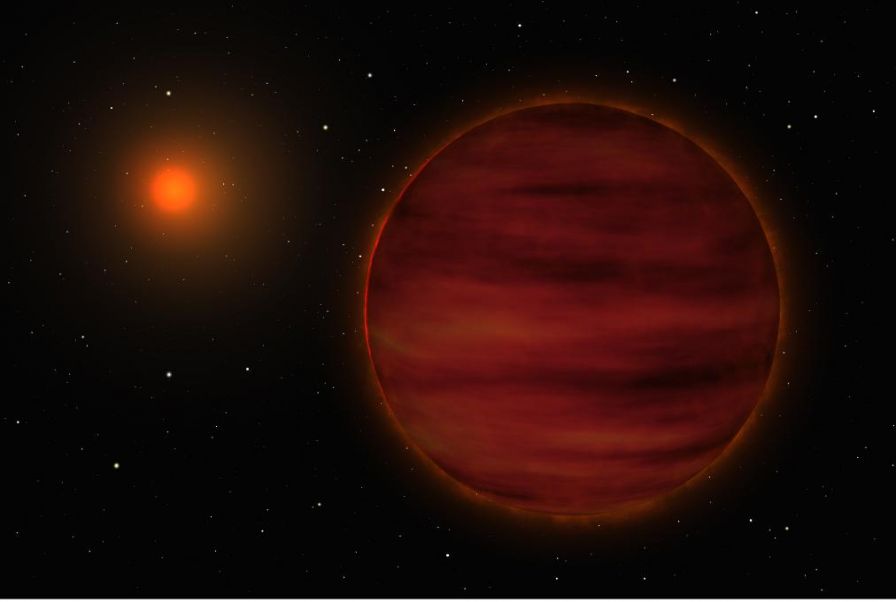
March 21, 2015-IFA News.
On March 21, Instituto de Física y Astronomía will host one of three Public Talks planned for the Día de la Astronomía en Chile 2015, organized by the Instituto Milenio de Astrofísica - MAS. Dr. Radostin Kurtev, associated investigator for MAS and professor at the Instituto de Física y Astronomía of the Universidad de Valparaíso will give a talk titled "Mundos fríos y extraños: El Descubrimiento y Naturaleza de las Enanas Marrones". That same day similar talks will be give in Santiago and Concepción, cities where MAS has a strong presence.
Complete Program for Día de la Astronomía en Chile 2015:
Santiago:
Speaker: Dr. Alejandro Clocchiatti, MAS Associated Investigator and professor of the Instituto de Astrofísica de la Pontificia Universidad Católica de Chile
Talk: “Chile una Ventana Abierta al Universo. Puerta abierta hacia el Futuro”
Venue: Auditorio Biblioteca de Santiago, Matucana 151, Metro Quinta Normal, Santiago.
Timetable: 11:30 AM
Inscriptions and more information: mas at astrofisica.cl
Valparaíso:
Speaker: Dr. Radostin Kurtev, MAS Associated Investigator and professor of the Instituto de Física y Astronomía de la Universidad de Valparaíso
Talk: “Mundos fríos y extraños. El Descubrimiento y Naturaleza de las Enanas Marrones”
Venue: Sala Rubén Darío Centro de Extensión at the Universidad de Valparaíso, Errázuriz 1108, Valparaíso.
Timetable: 18:30 PM
Inscriptions and more information: moira.evans at v.cl
Concepción:
Speaker: Dr. Wolfgang Gieren, MAS Associated Investigator and professor of the Departamento de Astronomía de la Universidad de Concepción.
Talk: “Las Distancias de la Galaxia y la Evolución del Universo”
Venue: Pending
Timetable: Pending
Inscriptions and more information: phernandezj at udec.cl
January 26, 2015. IFA News
On January 15 Dr. Pavlos Protopapas from the U. of Harvard visited the Instituto de Física y Astronomía to share developments in his work. Dr. Protopapas, world expert on "time domain astrophysics" gave a Seminar on his ambitious project for "classifying everything everywhere in the Universe" in Sala 11-A of the Facultad de Ciencias of our University. This event was attended by professors and exchange students for the U. de Chile, PUC and Harvard, program which the Universidad de Valparaiso hopes to join in the near future. More details on the Seminar:
"Classifying everything in the sky", Dr. Pavlos Protopapas, Harvard School of Engineering and Applied Sciences.
Abstract: In this talk I will present an ambitious goal of classifying all observed objects in the sky. In order to do so, we have been building the necessary methodologies and tools. This is multidisciplinary effort requires knowledge from astronomy, machine learning, statistics, signal processing, data management and software engineering. I will present the efforts of Phase1 that for now only includes mainly optical and time information (lightcurves). We are building classifiers that can deal with uncertain features, building efficient ensemble classifiers, using deep networks for feature extraction, period determination, outlier detection, imputing missing data, sequential learning for follow up recommendation etc.[Enero 26, 2015]



